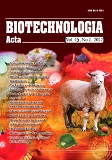ISSN 2410-7751 (Друкована версія)
ISSN 2410-776X (Електронна версія)

Biotechnologia Acta Т. 14, No. 2 , 2022
P. 72-73, Bibliography 3, Engl.
UDC: 577.112.616
https://doi.org/10.15407/biotech15.02.072
MOLECULAR BASIS OF THE DEVELOPMENT OF INSULIN RESISTANCE IN OBESE ADOLESCENT AND ADULT MEN
Y. Viletska1, D. Minchenko1, 2, O. Luzina1, O. Ratushna1
1Palladin Institute of Biochemistry, of the National Academy of Sciences of Ukraine, Kyiv
2Bohomolets National Medical University, Kyiv
The aim of this work was to study the association between the expression of glucose metabolism related genes and insulin resistance, which expression is changed in obese adolescents and adult men with and without insulin resistance, for better understanding the molecular basis of the development of obesity complications and evaluation of possible contribution of these genes in development of insulin resistance.
Methods. The expression level of genes related to glucose metabolism and their regulations was studied by real-time qPCR in adipose tissue and blood cells using SYBRGreen Mix and specific for each mRNA forward and reverse primers. Total RNA was extracted using TRIZOL reagent. For reverse transcription of mRNAs we used Thermo Scientific Verso cDNA Synthesis Kit (Germany). The values of mRNA expressions were normalized to the level of ACTB mRNA and represented as percent of control (100 %).
Results. It was shown that in obese patients with insulin resistance the expression level of IRS1 (insulin receptor substrate 1), HK2 (hexokinase 2), PFKFB2 (6-phosphofructokinase/fructose-2,6-bisphosphatase 2) and PFKFB3 as well as circadian factors CLOCK and ARNTL genes in subcutaneous adipose tissue is significantly decreased as compared to obese men with normal sensitivity to insulin. At the same time, the development of insulin resistance in obese patients leads to up-regulation of PFKFB4, PER1, HSPA6, ALDH1A3, COL5A1, TIMP1, TIMP2, SPARC, and VCAN gene expressions in subcutaneous adipose tissue. The expression level of IGF1 (insulin-like growth factor 1) and IGFBP5 (IGF binding protein 5) as well as ENO1 (enolase 1) and ENO2 is down-regulated in the blood of obese adolescent with insulin resistance, but IGFBP2 and IGFBP7 gene expressions are significantly increased in these patients.
Conclusions. The results of this investigation provide evidence that the development of insulin resistance in obese patients is associated with gene specific changes in the expression of many very important regulatory genes, which are endoplasmic reticulum stress responsible.
Key words: Artemisia tilesii, Artemisia annua, polyphenols, flavonoids, “hairy” roots, reversed-phase HPLC with diode matrix detector.
© Palladin Institute of Biochemistry of National Academy of Sciences of Ukraine, 2022
References
1. Minchenko D. O. Molecular bases of obesity development and its metabolic complications in children. Sovremennaia pediatriia. 2015, 2 (66), 109?112. (In Russian). https://doi.org/10.15574/SP.2015.66.109
2. Minchenko D. O. Insulin resistance in obese adolescents affects the expression of genes associated with immune response. Endocr. Reg., 2019, 53 (2), 71?82. https://doi.org/10.2478/enr-2019-0009
3. Minchenko O. H., Viletska Y. M., Minchenko D. O., Davydov V. V. Insulin resistance modifies the expression of proliferation related genes in obese adolescents and adult men. Ukr. Biochem. J. 2019, 91 (3), 65?77. https://doi.org/10.15407/ubj91.03.065

